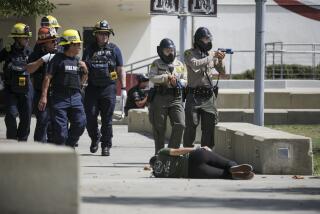State Adopts Science Education Standards
Third-graders should learn about the periodic table of elements. Fifth-graders should know the properties of common solids, liquids and gases. And high school students should master Newton’s first, second and third laws of motion.
Those are three of hundreds of new standards the State Board of Education adopted Friday for what students should be taught in science.
The vote, culminating a fractious yearlong debate over science education, put the state on the side of those who argue that students need to master more scientific facts, despite objections from others who emphasize hands-on experiments.
The board, meeting in Sacramento, also approved a less controversial set of standards for history and social studies, capping a lengthy process that last year produced similar new guidelines for reading, writing and math. Both votes were 10 to 0.
Now the challenge for California education officials is to ensure that the voluntary standards are actually followed in the classroom. Local school standards vary widely because what works in Yreka does not necessarily work in San Ysidro.
But the state board’s actions inevitably will have broad impact. As the nation’s largest textbook market, California may influence how schoolbooks are written for students in other states.
In addition, California is developing tests that will gauge how well students have mastered the knowledge that the standards call for. The statewide achievement test given last spring, known as the Stanford 9, was not in sync with the standards.
“The status quo is dead,” Yvonne W. Larsen, president of the board, said in a prepared statement.
Robert Trigg, vice president of the board, said state officials had received “overwhelmingly positive response from concerned educators and citizens from all over the country via the Internet.”
Nonetheless, the science standards drew criticism from many educators who say that children learn more by asking questions themselves and working on projects than by gleaning facts from lectures.
“Science in this state will be set back 30 years,” said Tania Madfes, a mathematics and science educator and a researcher in San Francisco for WestEd, an education laboratory funded in part by the federal government. “We’re getting away from science as understanding the world around you and into memorization--the kind of things most elementary teachers aren’t able to handle. It’s just a lot of vocabulary.”
The standards were drawn up by scientists and science educators including Glenn Seaborg, a Nobel Prize-winning chemist at UC Berkeley and a key figure in the history of nuclear physics. Seaborg participated in the groundbreaking 1983 report “A Nation at Risk,” which sounded an alarm about the decline of public schools.
Seaborg and two other Nobel laureates offered to consult on the science standards project for free. At first, their offer was rejected by the state panel charged with drafting standards. After coming under sharp criticism, the panel invited the eminent scientists to participate.
The standards include guidelines for student investigations and experiments, but they also emphasize factual knowledge of physical, Earth and life sciences in elementary school, building to more difficult concepts in high school.
More to Read
Sign up for Essential California
The most important California stories and recommendations in your inbox every morning.
You may occasionally receive promotional content from the Los Angeles Times.










